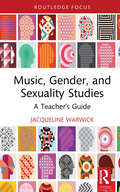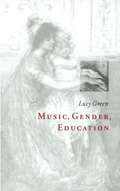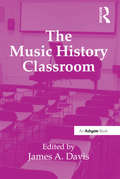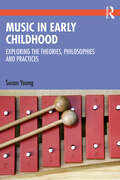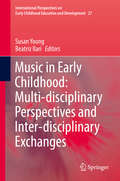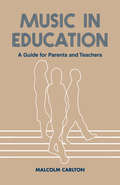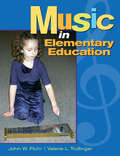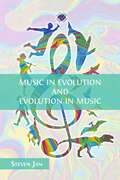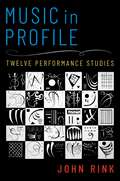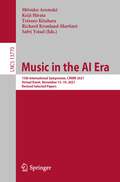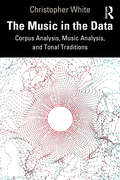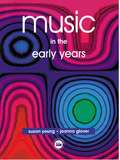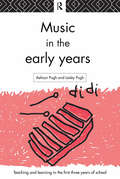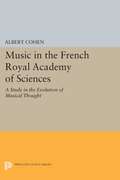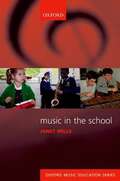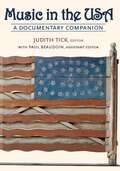- Table View
- List View
Music, Gender, and Sexuality Studies: A Teacher's Guide (Modern Musicology and the College Classroom)
by Jacqueline WarwickMusic, Gender, and Sexuality Studies: A Teacher’s Guide serves as a guide to the professor tasked with teaching music to undergraduates, with a focus on gender. Although the notion of feminist approaches in musicology was once greeted with scorn, the last 40 years have seen a seismic shift across music studies, to the point that classes on women and music are now commonplace in most undergraduate music program. The goal of this book is to give the instructor some tools and strategies that will build confidence in approaching music as it relates to gender and sexuality, and to offer some advice on how to make the class rewarding for all. The book is organized into four broad sections, plus an introduction outlining how to use the book and how the teaching of music, gender, and sexuality can be rewarding. Each section – Composition, Support, Performance, and Audience – includes possible themes for study and examples of music that can illuminate those themes, allowing the instructor to shape the course according to their own preference for classical, jazz, or popular styles. The author offers a practical guide to building syllabi that can fit the instructor’s interests and the priorities of the institution, crafting assignments that will engage and inspire students, choosing repertoire from a range of styles and genres, and maintaining a focus on how music shapes gender, and how gender shapes music.
Music, Gender, and Sexuality Studies: A Teacher's Guide (Modern Musicology and the College Classroom)
by Jacqueline WarwickMusic, Gender, and Sexuality Studies: A Teacher’s Guide serves as a guide to the professor tasked with teaching music to undergraduates, with a focus on gender. Although the notion of feminist approaches in musicology was once greeted with scorn, the last 40 years have seen a seismic shift across music studies, to the point that classes on women and music are now commonplace in most undergraduate music program. The goal of this book is to give the instructor some tools and strategies that will build confidence in approaching music as it relates to gender and sexuality, and to offer some advice on how to make the class rewarding for all. The book is organized into four broad sections, plus an introduction outlining how to use the book and how the teaching of music, gender, and sexuality can be rewarding. Each section – Composition, Support, Performance, and Audience – includes possible themes for study and examples of music that can illuminate those themes, allowing the instructor to shape the course according to their own preference for classical, jazz, or popular styles. The author offers a practical guide to building syllabi that can fit the instructor’s interests and the priorities of the institution, crafting assignments that will engage and inspire students, choosing repertoire from a range of styles and genres, and maintaining a focus on how music shapes gender, and how gender shapes music.
Music, Gender, Education (PDF)
by Lucy GreenThis book focuses on the role of education in relation to music and gender. Invoking a concept of musical patriarchy and a theory of the social construction musical meanings, Lucy Green shows how women's musical practices and gendered musical meanings have been reproduced, hand in hand, through history. Covering a wide range of music, including classical, jazz and popular styles, Dr Green uses ethnographic methods to convey the everyday interactions and experiences of girls, boys, and their teachers. She views the contemporary school music classroom as a microcosm of the wider society, and reveals the participation of music education in the continued production and reproduction of gendered musical practices and meanings.
The Music History Classroom
by James A. DavisThe Music History Classroom brings together essays written by recognized and experienced teachers to assist in the design, implementation, and revision of college-level music history courses. This includes the traditional music history survey for music majors, but the materials presented here are applicable to other music history courses for music majors and general education students alike, including period classes, composer or repertory courses, and special topics classes and seminars. The authors bring current thought on the scholarship of teaching and learning together with practical experience into the unique environment of the music history classroom. While many of the issues confronting teachers in other disciplines are pertinent to music history classes, this collection addresses the unique nature of musical materials and the challenges involved in negotiating between historical information, complex technical musical issues, and the aesthetics of performing and listening. This single volume provides a systematic outline of practical teaching advice on all facets of music history pedagogy, including course design, classroom technology, listening and writing assignments, and more. The Music History Classroom presents the 'nuts-and-bolts' of teaching music history suitable for graduate students, junior faculty, and seasoned teachers alike.
The Music History Classroom
by James A. DavisThe Music History Classroom brings together essays written by recognized and experienced teachers to assist in the design, implementation, and revision of college-level music history courses. This includes the traditional music history survey for music majors, but the materials presented here are applicable to other music history courses for music majors and general education students alike, including period classes, composer or repertory courses, and special topics classes and seminars. The authors bring current thought on the scholarship of teaching and learning together with practical experience into the unique environment of the music history classroom. While many of the issues confronting teachers in other disciplines are pertinent to music history classes, this collection addresses the unique nature of musical materials and the challenges involved in negotiating between historical information, complex technical musical issues, and the aesthetics of performing and listening. This single volume provides a systematic outline of practical teaching advice on all facets of music history pedagogy, including course design, classroom technology, listening and writing assignments, and more. The Music History Classroom presents the 'nuts-and-bolts' of teaching music history suitable for graduate students, junior faculty, and seasoned teachers alike.
Music in Early Childhood: Exploring the Theories, Philosophies and Practices
by Susan YoungMusic in Early Childhood is an accessible and practical handbook, which introduces theories and pedagogical approaches for early childhood music education from birth to 8 years and explains their practical application.Understanding the theories and philosophies behind music education and how these translate into practice is the key to being an effective music educator with young children. This book provides a comprehensive overview of these theories and philosophies. Organised in an easy-to-read format that summarises each approach and theory, the book clearly maps out how these theories are applied in present-day practice. Also included are a wide range of helpful practical examples and activity ideas based on the work of expert educators. This book aims: to inform educators of theories and philosophies of learning and teaching in music education for young children and what they look like in practice. to inform educators of the history and breadth of music education methods, and how they relate to the present. to help educators develop a theory-informed conception of music education that enables them to make informed decisions about the design and direction of their practice. This book is an essential resource for all early childhood music educators, experienced or just starting out, who want to develop their practice in working with young children as effectively as possible. It will promote an enquiring, reflective and imaginative approach to practice.
Music in Early Childhood: Exploring the Theories, Philosophies and Practices (International Perspectives On Early Childhood Education And Development Ser. #27)
by Susan YoungMusic in Early Childhood is an accessible and practical handbook, which introduces theories and pedagogical approaches for early childhood music education from birth to 8 years and explains their practical application.Understanding the theories and philosophies behind music education and how these translate into practice is the key to being an effective music educator with young children. This book provides a comprehensive overview of these theories and philosophies. Organised in an easy-to-read format that summarises each approach and theory, the book clearly maps out how these theories are applied in present-day practice. Also included are a wide range of helpful practical examples and activity ideas based on the work of expert educators. This book aims: to inform educators of theories and philosophies of learning and teaching in music education for young children and what they look like in practice. to inform educators of the history and breadth of music education methods, and how they relate to the present. to help educators develop a theory-informed conception of music education that enables them to make informed decisions about the design and direction of their practice. This book is an essential resource for all early childhood music educators, experienced or just starting out, who want to develop their practice in working with young children as effectively as possible. It will promote an enquiring, reflective and imaginative approach to practice.
Music in Early Childhood: Multi-disciplinary Perspectives And Inter-disciplinary Exchanges (International Perspectives on Early Childhood Education and Development #27)
by Susan Young Beatriz IlariThis book examines four main areas of music in early childhood: the traditions of music for young children, their capacities for music, the way they make music with others, and constructed and mediated musical childhoods. It studies several themes in detail, including music making in the home and family life, various musical experiences in schools, day cares, and the community at large in several locations around the globe. It looks at technology and diverse musical repertoires, as well as innovative pedagogies, children’s agency, and brain research. Expanding on the knowledge bases on which early childhood music education typically draws, the book brings together contributions from a range of authors from diverse fields such as education, psychology, sociology, cultural studies, anthropology, philosophy, ethnomusicology, and the neurosciences. The end result is a volume that offers a broad and contemporary picture of music in early childhood.
Music in Education: A Guide for Parents and Teachers
by Malcolm CarltonFirst published in 1987. Routledge is an imprint of Taylor & Francis, an informa company.
Music in Education: A Guide for Parents and Teachers
by Malcolm CarltonFirst published in 1987. Routledge is an imprint of Taylor & Francis, an informa company.
Music in Elementary Education
by John Flohr Valerie TrollingerBased on the National Standards, this text is divided into three parts. Part one, Foundations, covers the rationale for a Music Education program in the elementary years; meaning and musical experience; and elements and kinds of music. Part two– Music Elements, Curriculum and Avenues to Music Learning–covers curriculum development; music for special needs students; avenues to music learning and historic and contemporary approaches. Part three–Musical Experiences– is grouped by avenues of music learning and grades. Thanks to years of thorough research, Music in Elementary Education promises is a standard text in the field.
Music in Elementary Education
by John Flohr Valerie TrollingerBased on the National Standards, this text is divided into three parts. Part one, Foundations, covers the rationale for a Music Education program in the elementary years; meaning and musical experience; and elements and kinds of music. Part two– Music Elements, Curriculum and Avenues to Music Learning–covers curriculum development; music for special needs students; avenues to music learning and historic and contemporary approaches. Part three–Musical Experiences– is grouped by avenues of music learning and grades. Thanks to years of thorough research, Music in Elementary Education promises is a standard text in the field.
Music in Evolution and Evolution in Music: (pdf)
by Steven JanMusic in Evolution and Evolution in Music by Steven Jan is a comprehensive account of the relationships between evolutionary theory and music. Examining the ‘evolutionary algorithm’ that drives biological and musical-cultural evolution, the book provides a distinctive commentary on how musicality and music can shed light on our understanding of Darwin’s famous theory, and vice-versa. Comprised of seven chapters, with several musical examples, figures and definitions of terms, this original and accessible book is a valuable resource for anyone interested in the relationships between music and evolutionary thought. Jan guides the reader through key evolutionary ideas and the development of human musicality, before exploring cultural evolution, evolutionary ideas in musical scholarship, animal vocalisations, music generated through technology, and the nature of consciousness as an evolutionary phenomenon. A unique examination of how evolutionary thought intersects with music, Music in Evolution and Evolution in Music is essential to our understanding of how and why music arose in our species and why it is such a significant presence in our lives.
Music in Profile: Twelve Performance Studies
by John RinkUnderpinned by author John Rink's internationally acclaimed scholarship and experience as a musician, this book addresses fascinating topics in the field of musical performance studies concerning the history, analysis and psychology of music, as well as artistic research. It offers manifold practical insights into musical performance, ranging from detailed technical features to overall shape. The volume has four main parts, focusing on performance and performance studies, historical performance, analysis and performance, and artistic research. Case studies of romantic piano pieces appear throughout, including Liszt's 'Vall?e d'Obermann', Brahms's Fantasien Op. 116, and select preludes and concertos by Rachmaninoff and Chopin. The book also includes discussions of recordings by such artists as Alfred Brendel, Artur Rubinstein and Nikita Magaloff along with some outstanding performances in the International Fryderyk Chopin Piano Competition in 2015. Rink explores issues surrounding the identity and artistic voice of the performer by elucidating the sense-making and decision-making process underlying musical performance of all kinds. He also offers broad insights into musical ontology, epistemology and semantics, in addition to demonstrating some of the methodologies now used to study performance. As a whole, the book highlights the powerful effects that experiencing music in performance can have on those who take part in it, in any capacity.
Music in Profile: Twelve Performance Studies
by John RinkUnderpinned by author John Rink's internationally acclaimed scholarship and experience as a musician, this book addresses fascinating topics in the field of musical performance studies concerning the history, analysis and psychology of music, as well as artistic research. It offers manifold practical insights into musical performance, ranging from detailed technical features to overall shape. The volume has four main parts, focusing on performance and performance studies, historical performance, analysis and performance, and artistic research. Case studies of romantic piano pieces appear throughout, including Liszt's 'Vall?e d'Obermann', Brahms's Fantasien Op. 116, and select preludes and concertos by Rachmaninoff and Chopin. The book also includes discussions of recordings by such artists as Alfred Brendel, Artur Rubinstein and Nikita Magaloff along with some outstanding performances in the International Fryderyk Chopin Piano Competition in 2015. Rink explores issues surrounding the identity and artistic voice of the performer by elucidating the sense-making and decision-making process underlying musical performance of all kinds. He also offers broad insights into musical ontology, epistemology and semantics, in addition to demonstrating some of the methodologies now used to study performance. As a whole, the book highlights the powerful effects that experiencing music in performance can have on those who take part in it, in any capacity.
Music in the AI Era: 15th International Symposium, CMMR 2021, Virtual Event, November 15–19, 2021, Revised Selected Papers (Lecture Notes in Computer Science #13770)
by Mitsuko Aramaki Keiji Hirata Tetsuro Kitahara Richard Kronland-Martinet Sølvi YstadThis book constitutes the refereed proceedings and revised selected papers from the 15th International Symposium on Music in the AI Era, CMMR 2021, which took place during November 15–19, 2021 as a virtual event. The 24 full papers included in this book were carefully reviewed and selected from 48 submissions. The papers are grouped in thematical sessions on Music technology in the IA era; Interactive systems for music; Music Information Retrieval and Modeling; and Music and Performance Analysis.
The Music in the Data: Corpus Analysis, Music Analysis, and Tonal Traditions
by Christopher WhitePutting forward an extensive new argument for a humanities-based approach to big-data analysis, The Music in the Data shows how large datasets of music, or music corpora, can be productively integrated with the qualitative questions at the heart of music research. The author argues that as well as providing objective evidence, music corpora can themselves be treated as texts to be subjectively read and creatively interpreted, allowing new levels of understanding and insight into music traditions. Each chapter in this book asks how we define a core music-theory topic, such as style, harmony, meter, function, and musical key, and then approaches the topic through considering trends within large musical datasets, applying a combination of quantitative analysis and qualitative interpretation. Throughout, several basic techniques of data analysis are introduced and explained, with supporting materials available online. Connecting the empirical information from corpus analysis with theories of musical and textual meaning, and showing how each approach can enrich the other, this book provides a vital perspective for scholars and students in music theory, musicology, and all areas of music research.
The Music in the Data: Corpus Analysis, Music Analysis, and Tonal Traditions
by Christopher WhitePutting forward an extensive new argument for a humanities-based approach to big-data analysis, The Music in the Data shows how large datasets of music, or music corpora, can be productively integrated with the qualitative questions at the heart of music research. The author argues that as well as providing objective evidence, music corpora can themselves be treated as texts to be subjectively read and creatively interpreted, allowing new levels of understanding and insight into music traditions. Each chapter in this book asks how we define a core music-theory topic, such as style, harmony, meter, function, and musical key, and then approaches the topic through considering trends within large musical datasets, applying a combination of quantitative analysis and qualitative interpretation. Throughout, several basic techniques of data analysis are introduced and explained, with supporting materials available online. Connecting the empirical information from corpus analysis with theories of musical and textual meaning, and showing how each approach can enrich the other, this book provides a vital perspective for scholars and students in music theory, musicology, and all areas of music research.
Music in the Early Years
by Joanna Glover Susan YoungMusic in the Early Years is for teachers working across the 3 to 8 age phase who want to make music integral to the life of the nursery and early years classroom.Music has often been taught as if it were different, something outside the mainstream curriculum, with teaching approaches quite at odds with early years work. This book takes children's development as its basis and works towards building a music pedagogy within early years practice. A readiness to listen, observe and reflect is central to the practice which threads through the book.Based on the authors' extensive experience and drawing on that of other teachers and researchers, lots of well-tried, practical ideas show how teachers, parents and carers can help children fulfil their music potential. Sample activities model ways of working with children and have been written in such a way that they can be substituted with other material and adapted for further use. Earlier and later stages of learning and progression are described as a basis for matching activities with children's learning needs, as well as a companion book, Primary Music: Later Years.
Music in the Early Years
by Joanna Glover Susan YoungMusic in the Early Years is for teachers working across the 3 to 8 age phase who want to make music integral to the life of the nursery and early years classroom.Music has often been taught as if it were different, something outside the mainstream curriculum, with teaching approaches quite at odds with early years work. This book takes children's development as its basis and works towards building a music pedagogy within early years practice. A readiness to listen, observe and reflect is central to the practice which threads through the book.Based on the authors' extensive experience and drawing on that of other teachers and researchers, lots of well-tried, practical ideas show how teachers, parents and carers can help children fulfil their music potential. Sample activities model ways of working with children and have been written in such a way that they can be substituted with other material and adapted for further use. Earlier and later stages of learning and progression are described as a basis for matching activities with children's learning needs, as well as a companion book, Primary Music: Later Years.
Music in the Early Years
by Aelwyn Pugh Lesley PughResearch findings repeatedly show that music is one of the subjects which teachers feel least confident to tackle. There are many reasons for this, not least being the lack of appropriate guidance and training. This book is designed to help overcome these problems by providing class teachers with clear advice on how to plan, resource and deliver a comprehensive programme which will challenge their pupils and enable them to progress and meet national requirements. The book includes examples and activities which can be used as a basis for in-service training within schools, particularly for teachers who regard themselves as non-specialists.
Music in the Early Years (Teaching And Learning In The Early Years Ser.)
by Aelwyn Pugh Lesley PughResearch findings repeatedly show that music is one of the subjects which teachers feel least confident to tackle. There are many reasons for this, not least being the lack of appropriate guidance and training. This book is designed to help overcome these problems by providing class teachers with clear advice on how to plan, resource and deliver a comprehensive programme which will challenge their pupils and enable them to progress and meet national requirements. The book includes examples and activities which can be used as a basis for in-service training within schools, particularly for teachers who regard themselves as non-specialists.
Music in the French Royal Academy of Sciences: A Study in the Evolution of Musical Thought
by Albert CohenThis book describes a colorful period in French social and cultural history, during which music and science combined to provide the intellectual and aesthetic spirit of the Age of Enlightenment with an enormous vitality. Investigating the place assigned to music in France's preeminent scientific institution, the Paris Academy, the author shows the role played by the scientific movement in the evolution of musical thought prior to the Revolution.Originally published in 1982.The Princeton Legacy Library uses the latest print-on-demand technology to again make available previously out-of-print books from the distinguished backlist of Princeton University Press. These editions preserve the original texts of these important books while presenting them in durable paperback and hardcover editions. The goal of the Princeton Legacy Library is to vastly increase access to the rich scholarly heritage found in the thousands of books published by Princeton University Press since its founding in 1905.
Music in the School: (pdf)
by Janet MillsHow do some schools get music so right while others get it so wrong? Janet Mills, a former HMI and teacher, draws on work in more than 800 schools and published research as she seeks to help schools improve their practice - no matter how good it is already. Successful teaching, she argues, is creative, uplifting, enabling, and, above all, rooted in music. The aim of this book is to 'Put the music back into music'.Thought-provoking, challenging, and empowering, this book is an essential read for all those interested in music in schools, including class teachers, instrumental teachers, and researchers. Using informative and entertaining examples and anecdotes, Janet Mills criticizes notions such as 'musical children' and 'musical schools', and comments on the roles of instrumental teachers and so-called 'non-specialists'. She explores how music in school can, and must, interact with music out of school, and considers how to measure progress in music - and how not to. Music in the School is not a step-by-step guide to better teaching, but rather a springboard for consideration, reflection, and action. Anyone who cares about music at school will find this book a powerful tool.
Music in the USA: A Documentary Companion
by Judith Tick Paul BeaudoinMusic in the USA: A Documentary Companion charts a path through American music and musical life using as guides the words of composers, performers, writers and the rest of us ordinary folks who sing, dance, and listen. The anthology of primary sources contains about 160 selections from 1540 to 2000. Sometimes the sources are classics in the literature around American music, for example, the Preface to the Bay Psalm Book, excerpts from Slave Songs of the United States, and Charles Ives extolling Emerson. But many other selections offer uncommon sources, including a satirical story about a Yankee music teacher; various columns from 19th-century German American newspapers; the memoirs of a 19th-century diva; Lottie Joplin remembering her husband Scott; a little-known reflection of Copland about Stravinsky; an interview with Muddy Waters from the Chicago Defender; a letter from Woody Guthrie on the "spunkfire" attitude of a folk song; a press release from the Country Music Association; and the Congressional testimony around "Napster." "Sidebar" entries occasionally bring a topic or an idea into the present, acknowledging the extent to which revivals of many kinds of music play a role in American contemporary culture. This book focuses on the connections between theory and practice to enrich our understanding of the diversity of American musical experiences. Designed especially to accompany college courses which survey American music as a whole, the book is also relevant to courses in American history and American Studies.
